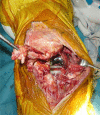Repair of patellar tendon rupture after total knee arthroplasty using knotless suture bridge technique: a case report
- PMID: 35692302
- PMCID: PMC9183454
- DOI: 10.1093/jscr/rjac167
Repair of patellar tendon rupture after total knee arthroplasty using knotless suture bridge technique: a case report
Abstract
Few studies have reported on the use of knotless suture anchors to treat patellar tendon rupture from tibial tuberosity after total knee arthroplasty (TKA). We report a case of patellar tendon rupture in an 82-year-old female. She fell 8 weeks after bilateral TKA and presented with a patellar tendon rupture. A knotless suture anchor and a fully threaded Twist-In knotless anchor with flat-braided suture were used to repairing the patellar tendon. Complications related to the extension mechanism after TKA can lead to disastrous consequences. This surgical procedure is a safe and good treatment option to repair patellar tendon rupture after TKA.
Published by Oxford University Press and JSCR Publishing Ltd. © The Author(s) 2022.
Figures





Similar articles
-
Hybrid Knot and Knotless Suture Anchor Repair for Patellar Tendon Rupture.Video J Sports Med. 2022 Oct 20;2(5):26350254221119217. doi: 10.1177/26350254221119217. eCollection 2022 Sep-Oct. Video J Sports Med. 2022. PMID: 40309462 Free PMC article.
-
Bilateral Spontaneous Midsubstance Patellar Tendon Rupture after Bilateral Total Knee Arthroplasty.J Orthop Case Rep. 2016 Apr-Jun;6(2):75-77. doi: 10.13107/jocr.2250-0685.444. J Orthop Case Rep. 2016. PMID: 27703942 Free PMC article.
-
Suture anchor repair of patellar tendon rupture after total knee arthroplasty.J Knee Surg. 2013 Dec;26 Suppl 1:S128-31. doi: 10.1055/s-0032-1329234. Epub 2012 Nov 12. J Knee Surg. 2013. PMID: 23288736
-
Acute patellar tendon rupture with tibial tubercle avulsion repair using suture anchors: Tiny avulsed fragment which affects the strength of construction-a case report.Int J Surg Case Rep. 2022 Jul;96:107283. doi: 10.1016/j.ijscr.2022.107283. Epub 2022 Jun 10. Int J Surg Case Rep. 2022. PMID: 35751965 Free PMC article.
-
Suture anchor repair of quadriceps tendon rupture after total knee arthroplasty.J Arthroplasty. 2011 Aug;26(5):817-20. doi: 10.1016/j.arth.2011.01.006. Epub 2011 Mar 11. J Arthroplasty. 2011. PMID: 21397449 Review.
Cited by
-
Surgical treatment of patellar tendon rupture after total knee arthroplasty with a double-row repair method using the hamstring tendons: A novel technique with functional results.Medicine (Baltimore). 2024 Apr 26;103(17):e37875. doi: 10.1097/MD.0000000000037875. Medicine (Baltimore). 2024. PMID: 38669383 Free PMC article.
-
Bilateral patellar tendon repair with suture bridge augmentation: A case report.Trauma Case Rep. 2024 Sep 14;54:101097. doi: 10.1016/j.tcr.2024.101097. eCollection 2024 Dec. Trauma Case Rep. 2024. PMID: 39318769 Free PMC article.
References
-
- Cadambi A, Engh GA. Use of a semitendinosus tendon autogenous graft for rupture of the patellar ligament after total knee arthroplasty. A report of seven cases. J Bone Joint Surg Am 1992;74:974–9. - PubMed
-
- Lynch AF, Rorabeck CH, Bourne RB. Extensor mechanism complications following total knee arthroplasty. J Arthroplasty 1987;2:135–40. - PubMed
-
- Vajapey SP, Blackwell RE, Maki AJ, Miller TL. Treatment of extensor tendon disruption after total knee arthroplasty: a systematic review. J Arthroplasty 2019;34:1279–86. - PubMed
-
- Parker DA, Dunbar MJ, Rorabeck CH. Extensor mechanism failure associated with total knee arthroplasty: prevention and management. J Am Acad Orthop Surg 2003;11:238–47. - PubMed
-
- Chhapan J, Sankineani SR, Chiranjeevi T, Reddy MV. Early quadriceps tendon rupture after primary total knee arthroplasty. Knee 2018;25:192–4. - PubMed
Publication types
LinkOut - more resources
Full Text Sources

